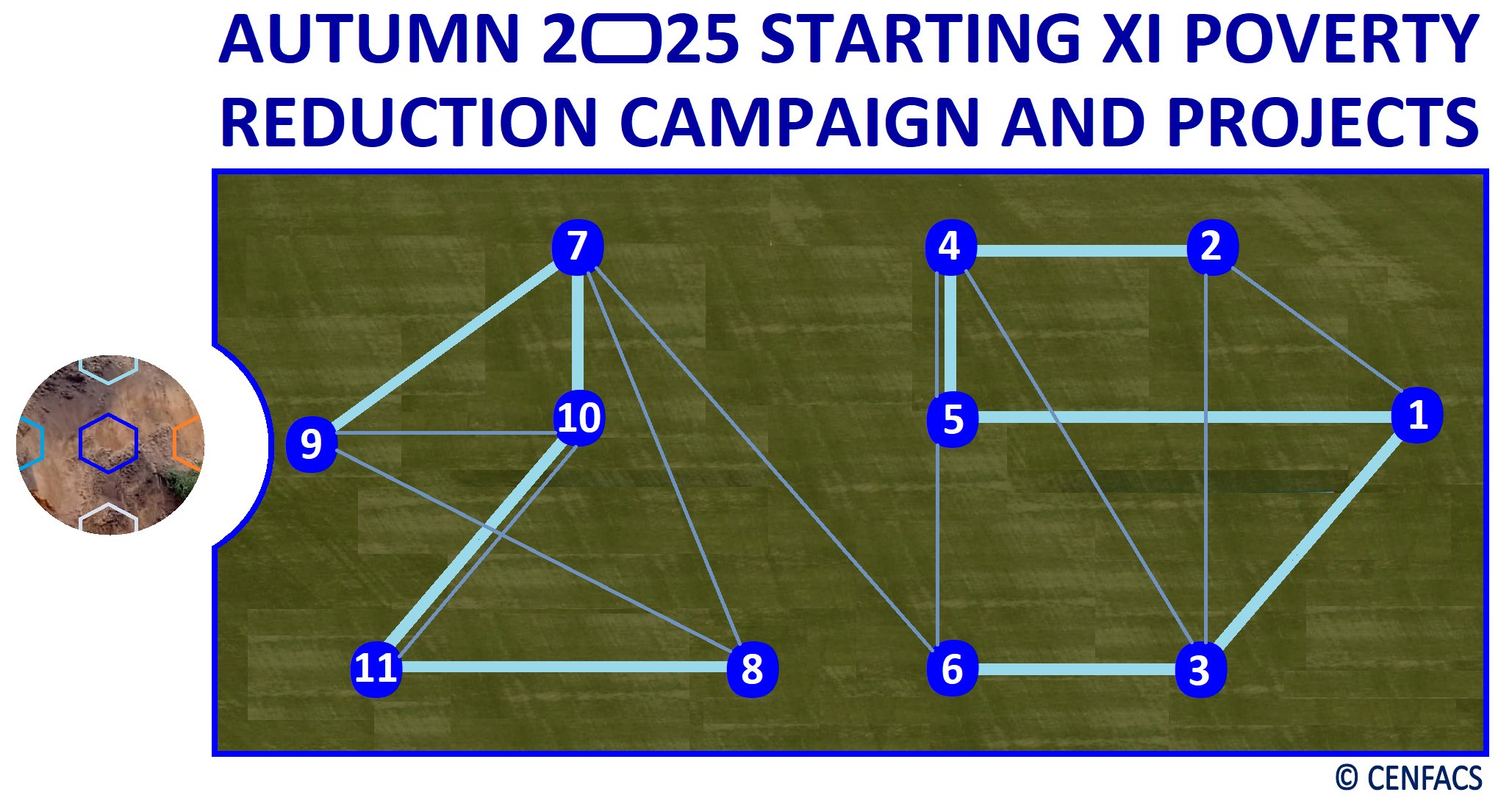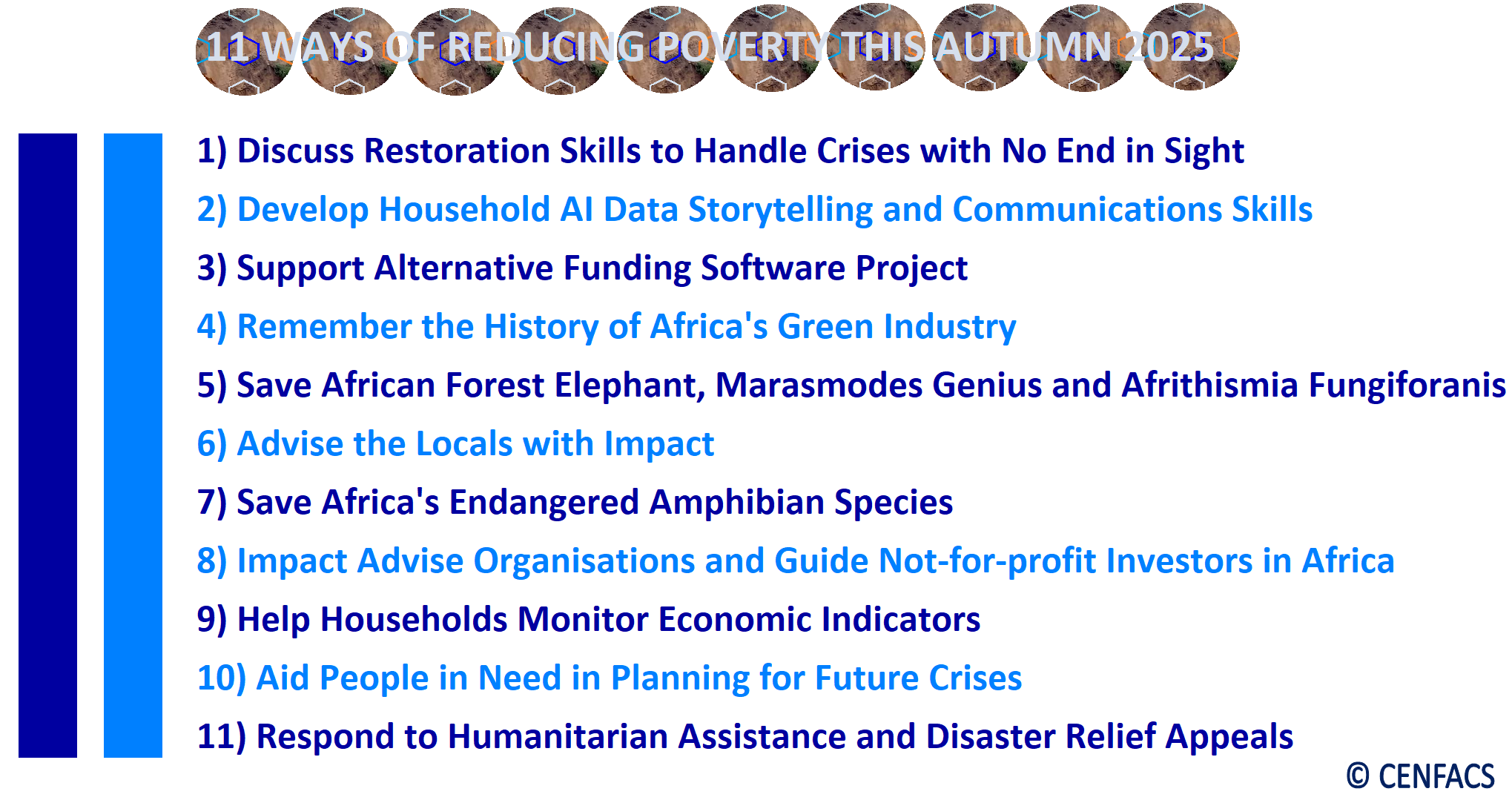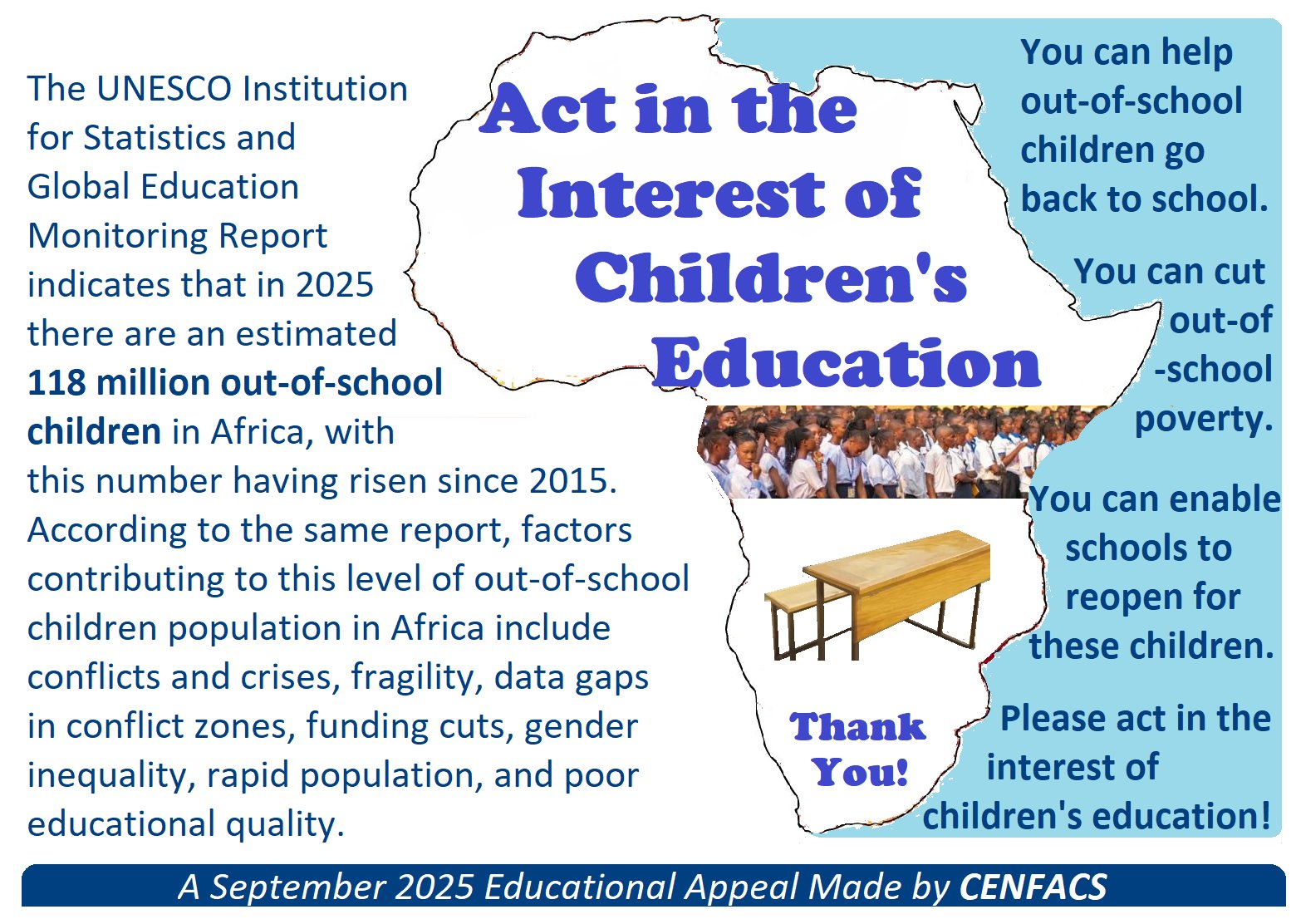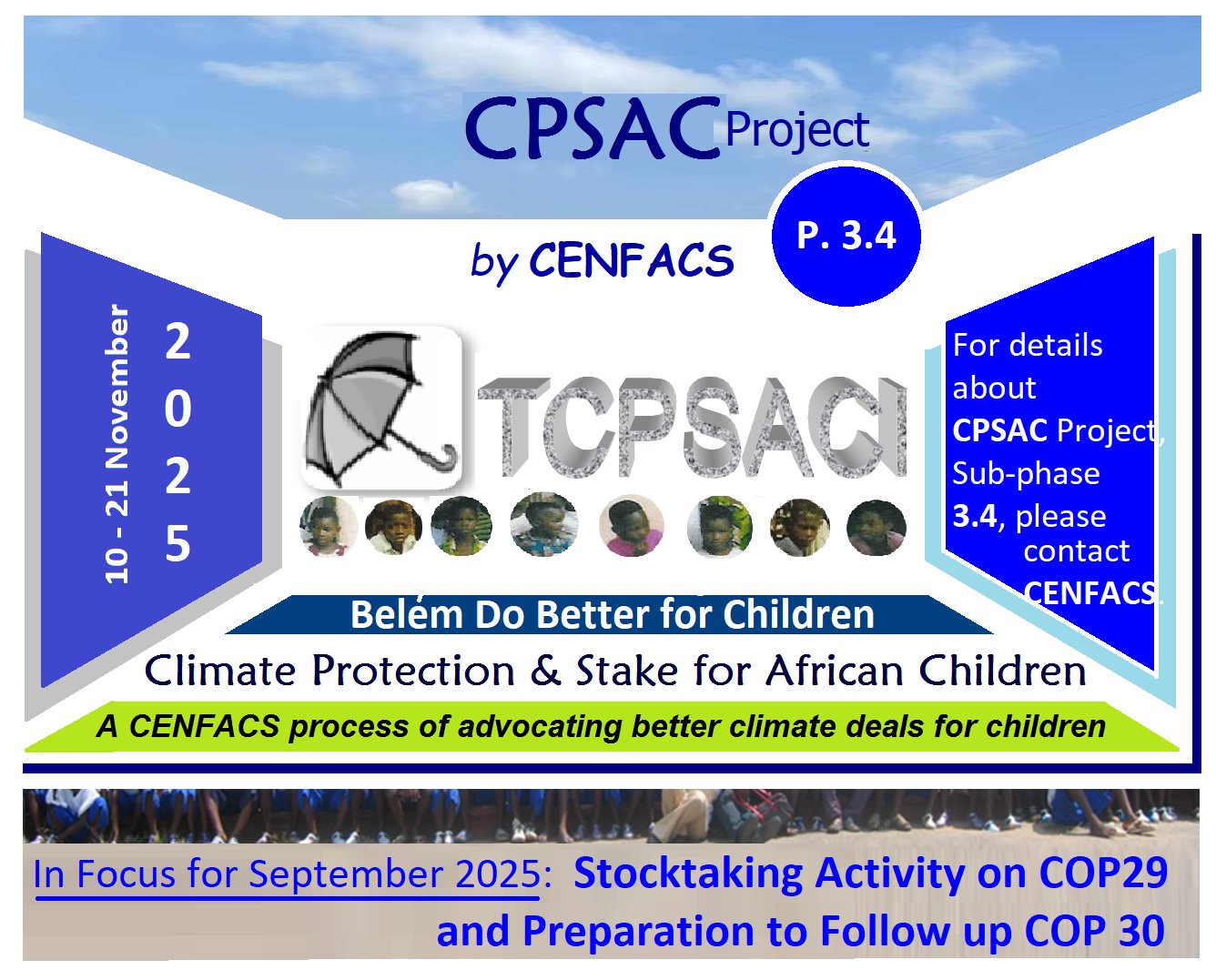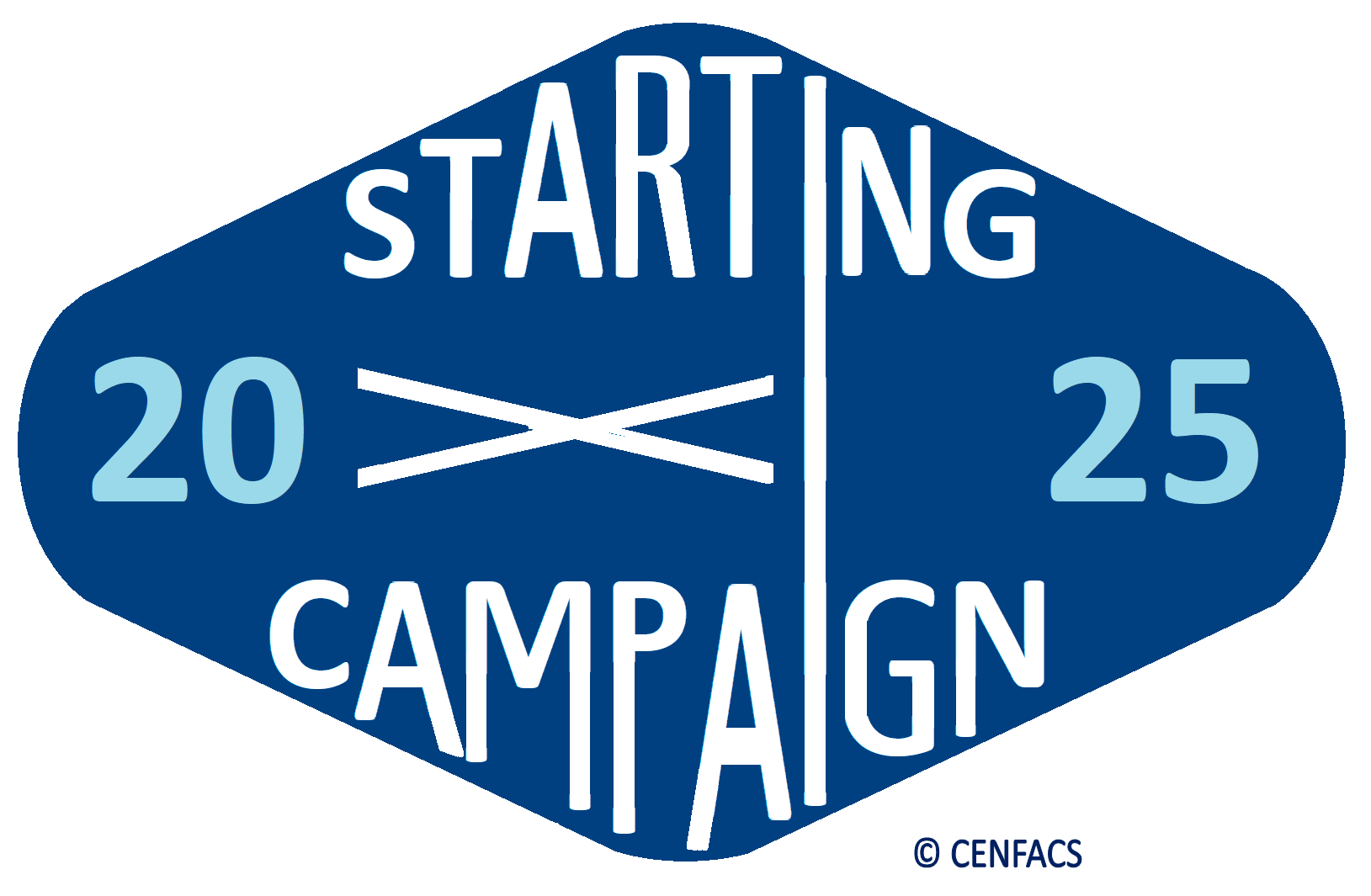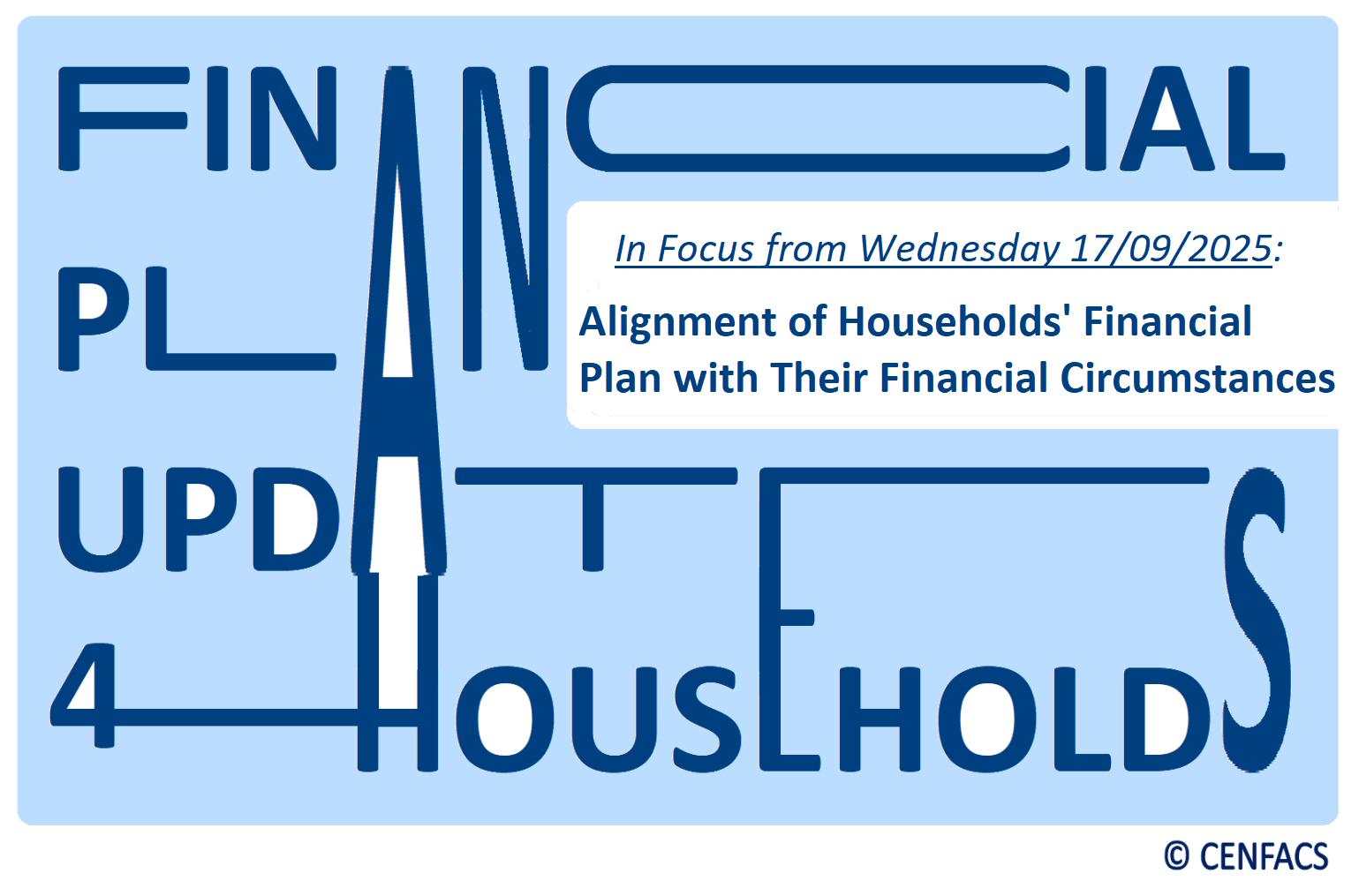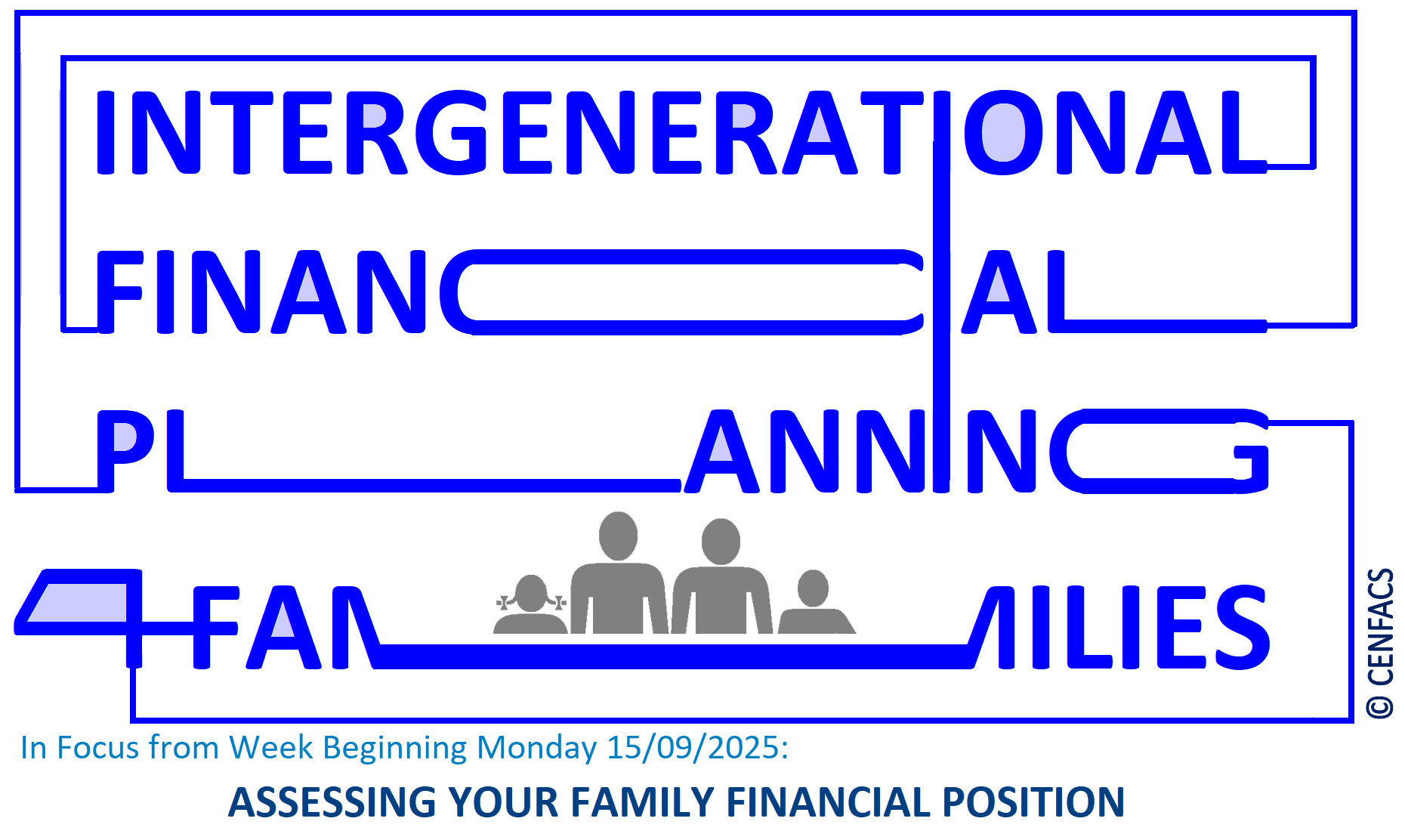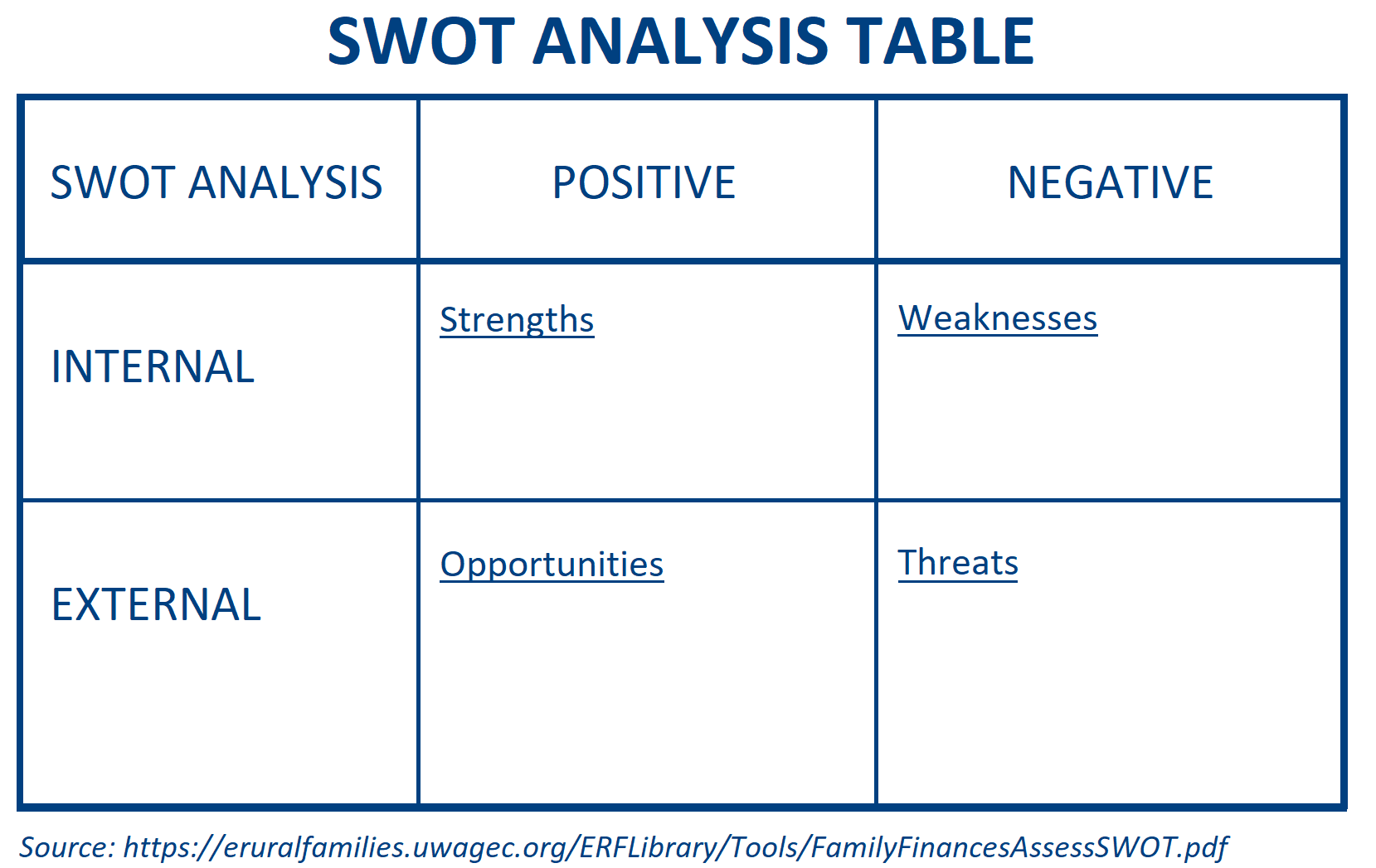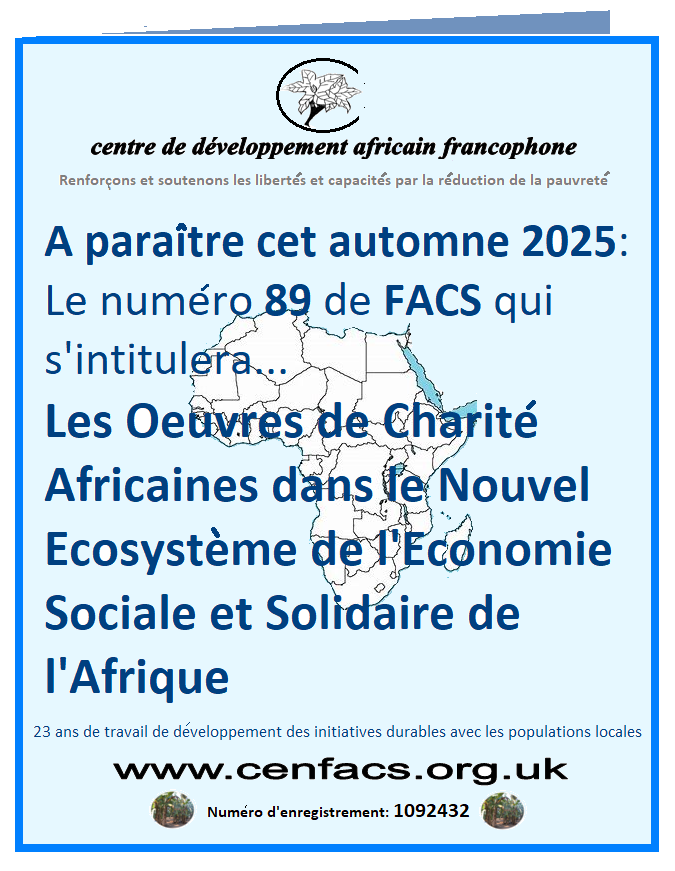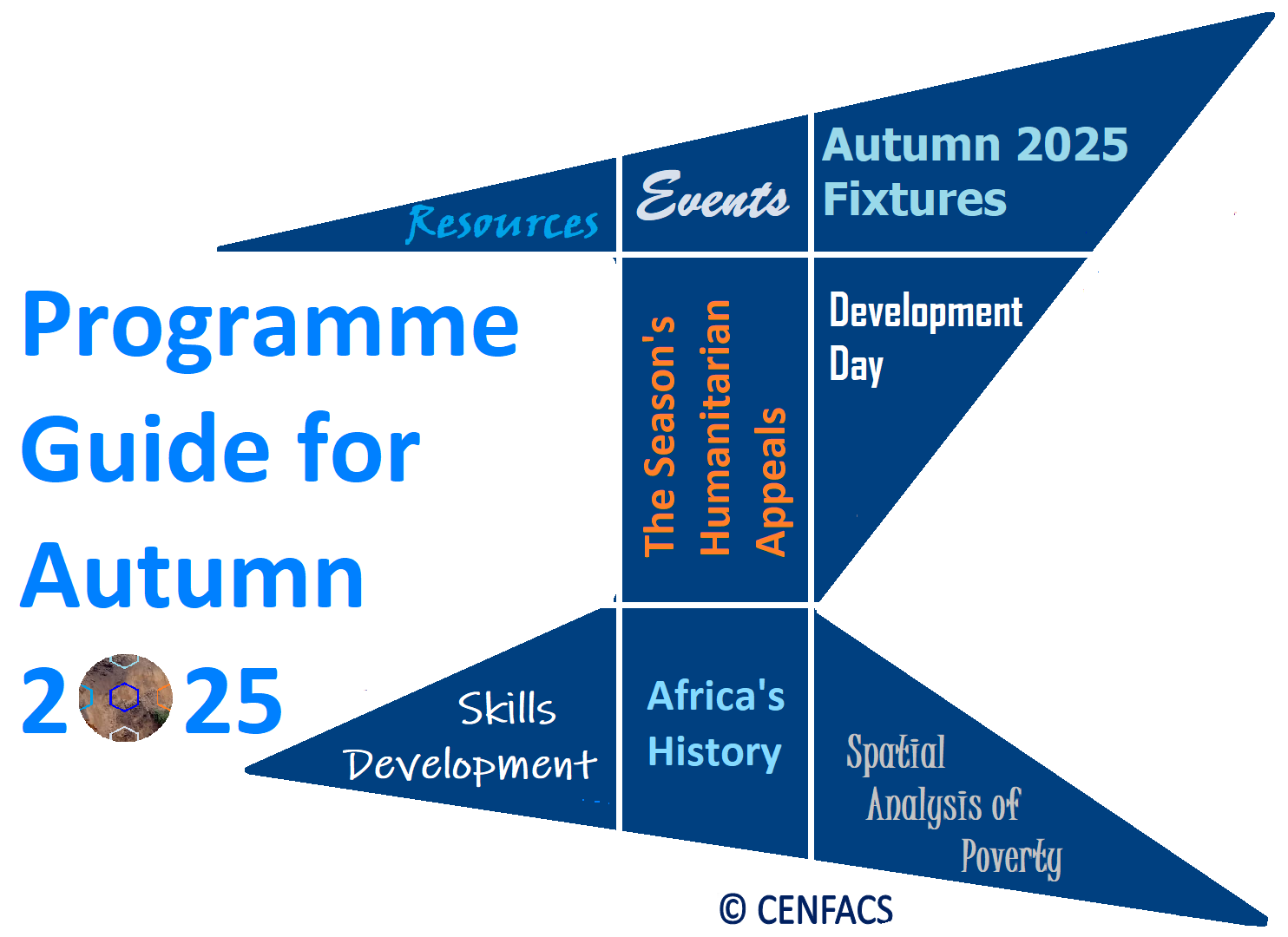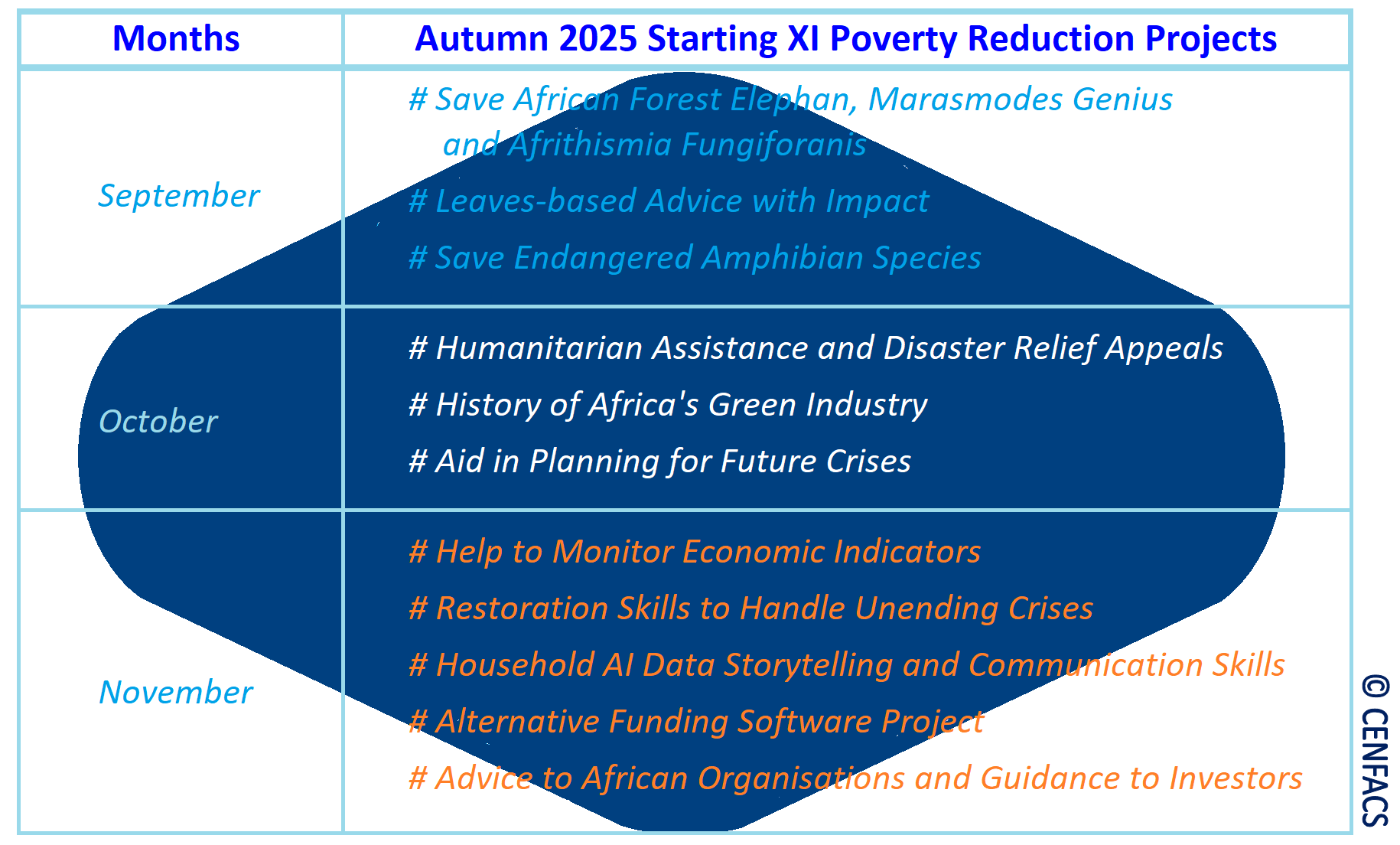Welcome to CENFACS’ Online Diary!
17 September 2025
Post No. 422
The Week’s Contents
• Autumn 2025 Starting XI Poverty Reduction Projects and Campaign
• Orange Spaces-focused Note from Wednesday 17/09/2025: Eliminating Poverty Attached to a Group Visually Depicted by Orange Space
• Tacking Climate Protection and Stake for African Children at the Implementation Level with Full Implementation Sub-phase (Phase 3.4): Stocktaking Activity on COP29 and Preparation to Follow up COP30
… And much more!
Key Messages
• Autumn 2025 Starting XI Poverty Reduction Projects and Campaign
To start the eleven projects we planned for our Autumn 2025 Poverty Reduction Campaign, let first explain Autumn Fresh Start Season.
• • What Is Autumn about for CENFACS and Its Community?
It is about Freshness. Autumn is the time of natural recycling process of plants and trees. Leaves change colour and fall. Without reinventing the wheels, we can say that Autumn of Freshness at CENFACS is the season after the long sunny weather and break of Summer; season during which our body and mind naturally recycle and engage in renewed energy, strength and thoughts.
Autumn of Freshness is the season of
∝ making fresh start after returning back from Summer to resume our life routine, work, education and voluntary work, particularly poverty relief one
∝ restarting after having some life and/or work experience (e.g., voluntary work or experience over the Summer, project visits, holiday trips, family sojourns, tourism, travel/expeditions of all kinds, etc.)
∝ beginning to apply or introduce and share those new experiences, ideas and discoveries we had during the Summer break or holiday
∝ slowing down some types of things while gradually setting up new ones from small to big sizes
∝ novelty, creativity and innovation to try to resolve the old, new, challenging and emerging issues of poverty and hardships.
Will this Autumn be same as the previous ones?
• • Autumn of Freshness 2025: With a Focus on What to Do if a Crisis Shows No Signs of Ending
This Autumn 2025, we are going to try find ways forward to deal with unending crisis like the cost-of-living one.
Finding ways forward to deal with unending crisis is also about answering these questions:
How does economic crisis end? Does it end itself following the business or trade cycle model or fluctuations in the level of economic activity (that is, depression, recovery, boom, recession and so on)? Does it end through an intervention in the form of economic policy response?
There are different responses to these questions. For instance, the website ‘econofact.org’ (1) argues that
“History suggests two ingredients are needed to stanch the acute phase of an economic crisis: a resolution of the underlying cause and a dramatic economic policy response that mitigates the economic damage and causes a shift in the sentiment”.
There have been attempts to end the cost-of-living crisis, but the cost-of-living crisis is still there. Economically speaking, it will end when real disposable incomes match the level of prices. At the moment, this matching is not happening.
According to ‘expatistan.com’ (2),
“The estimated monthly costs of a family of four is £4,539, the UK is the 4th most expensive country in Western Europe (4 out of 14), and the cost of living in the UK is more expensive than in 89% of countries in the world (7 out of 55).
Similarly, ‘statistica.com’ (3) notes that
“In September 2025, the inflation rate in the UK is expected to peak at 4% according to the Bank of England. Following this peak, inflation is predicted to fall back to 3.6% by the end of 2025. The annual inflation rate for the UK is forecasted to rise to 3.2% in 2025 overall”.
To find new ways forward, we may need to keep refreshing the methods, approaches, theories, systems, practices and tools we have been using to tackle the cost-of-living crisis. Why do we need to find ways forward to deal with unending crisis like the cost-of-living one?
Many economic analysts and expert bodies (like the Institute of Chartered Accountants in England and Wales, the Resolution Foundation, chief economists at World Economic Forum, etc.) thought that the cost-of-living crisis would last until the end of 2024, when household real disposable incomes would increase and inflation would drop back. Yet, the inflation is expected to be between 3.2% and 4%, which is above the UK government target of 2%.
Some even predicted that the cost-of-living crisis would carry on up to 2027/2028. If this is the case, at the moment we are in the scenario of unending cost-of-living crisis since it began.
If this is the case or scenario, one may need to find what to do with an unending cost-of-living crisis or to refresh their autumnal strategy through which they are dealing with the cost-of-living crisis. Let alone the economic theory they are using. Ways forward to What to Do if a Crisis Shows No Signs of Ending and refreshing are needed within CENFACS, between CENFACS and its community for the following reasons:
σ to conduct a brand refresh used or take a process of adjusting the brand in the fight against the cost-of-living crisis
σ to update with the latest information and knowledge about this crisis
σ to fix projects, activities and programme areas which are not working or where there are bugs
σ to review some of the fundamentals
σ to refresh values from an improved perspective
σ to take refresher training to close the gaps in knowledge in the way of tackling the cost-of-living crisis
σ to stay in tune with changing project beneficiaries’ tastes and technological innovation (like Artificial Intelligence powered technologies) causing new services to emerge which may supersede existing ones
σ briefly to keep control on the life cycle (that is launch, growth, maturity and decline) of CENFACS‘ products/services while finding a new way forward to deal with unending cost-of-living crisis.
All these reasons will help find new way forward to deal with unending cost-of-living crisis, which has been tackled since inflation went far ahead wages. They will also assist in dealing with other enduring polycrises like climate crisis.
However, we have to admit that CENFACS does not have the capacity to end the cost-of-living crisis. CENFACS can however work with those affected by the lingering effects of the cost-of-living crisis to reduce or end these harmful effects on them. As the ‘verywellmind.com’ (4) puts it when referring to trauma:
“Fortunately, there are healthy ways to cope with a crisis and get to the other side”.
CENFACS will continue to work with those stricken by the cost-of-living crisis and its lingering effects so that they can get to the other side of the crisis.
So, the key words and phrases for our sharing and engaging contents over this Autumn are Finding or Refreshing or Reviving What to Do if a Crisis Shows No Signs of Ending; words and phrases which will underpin all our work over this period.

• • Autumn 2025 Starting XI Poverty Reduction Campaign: Autumn Programme with Starting XI Poverty Reduction Projects to Find What to Do if a Crisis Shows No Signs of Ending
Autumn of Freshness is about working together with our users, project beneficiaries, members and stakeholders through a helpful bundle of Fresh Start projects blended together to give a contemporary and targeted relief, thanks to a good knowledge of users’ and members’ needs and expectations.
These projects will help implement new and improved ways of working with local people to meet changing needs mainly led by the lingering effects of the previous crises (e.g., the coronavirus disaster) and the enduring cost-of-living crisis in the Year of Restoration; a year of restoration skills to meet poor people’s needs in a new era (of Generative Artificial Intelligence Chatbots or AI-powered Chatbots) and landscape of poverty reduction and development policies. These projects make up our Autumn 2025 Fresh Start Programme.
• • What Is Included in the Autumn 2025 Fresh Start Programme?
The Autumn 2025 Fresh Start Programme is made of
(a) Skills, tips, hints, tweaks, tools and hacks to find ways to deal with unending cost-of-living crisis or refresh ways of ending the cost-of-living crisis
(b) Transformative and restoration experiences
(c) The Season’s appeal to stand up again against poverty and hardships
(d) A Slice and feast of Africa’s history
(e) A Campaign to end the unending cost-of-living crisis
(f) A Spatial analysis of poverty via orange, brown, blue, green and grey spaces
(g) Blue and green realignments of initiatives to the principles of greenhouse gas emissions reduction goals and targets
(h) Colour-based visual themes and representation of poverty in mapping activities
(i) Thoughts and inspirations to finish the unfinished work of building forward from previous crises.
All this is flavoured with hopes, dreams and reasons to believe in the future; a poverty-free, sustainable, net zero and crisis-free world.
So, the line-up for CENFACS’ Autumn 2025 Starting XI Poverty Reduction Projects and Campaign to Find What to Do if a Crisis Shows No Signs of Ending and deal with other crises for this Autumn is as follows:
1) Women, Children and Restoration Skills for Handling a Crisis with No End in Sight – NEW
2) Household AI Data Storytelling and Communications Skills – UPGRADED
3) Alternative Funding Software Project – NEW
4) Making Memorable Difference through Africa’s Green Industry
5) Save African Forest Elephant, Marasmodes Genius and Afrithismia Fungiforanis
6) Leaves-based Advice with Impact
7) “A la Une” (Autumn Leaves of Action for the Upkeep of the Nature in Existence) with a Focus on Critically Endangered Amphibian Species
8) Advice for Africa-based Sister Organisations and Guidance for Not-for-profit Impact Investing in Africa
9) Autumn Helps to Monitor Economic Indicators – NEW
10) Aid in Planning for Future Crises – NEW
11) Autumn Humanitarian Assistance and Disaster Relief Appeals.
For more on these projects, please read below under the Main Development section of this post.
• Orange Spaces-focused Note from Wednesday 17/09/2025: Eliminating Poverty Attached to a Group Visually Depicted by Orange Space
Our spatial analysis of poverty together with the study of poverty through colour economy continue this week. Last week, we recognised that Orange Space is a visual concept that visualises disadvantage, identifies vulnerable populations, and can be used to support targeted interventions.
This week, we are trying to find out the meaning of Orange Space in the context of poverty reduction and sustainable development. Indeed, Orange Space can used as a thematic campaign to raise awareness about and to fund poverty. It can also be utilised as a tool for sustainable development.
Let us summarise how Orange Space can be used both as a campaign theme for poverty reduction and a tool for sustainable development, as well as how we can work with the community on ‘Orange Space‘ matter.
• • Orange Space as a Campaign Theme to Reduce Poverty
Orange Space can be used as a way to fight poverty and support organisations that work to alleviate it. It can be utilised to reduce or end poverty attached to a group that has been visualised or identified or differentiated as poor in a spatial analysis by orange colour or space. It can be employed in fundraising activities or events to raise money to meet the needs of such group or any other good causes.
For instance, in the UK the Charity ‘Turn2Us’ has a specific annual event where people dress in orange colour to raise awareness and money during a Challenge Poverty Week. ‘Turn2Us’ with its “Go Orange” campaign encourages people to wear orange to raise awareness and funds for financial insecurity.
Orange Space can also be used to acknowledge the interconnectedness of issues whereby environmental, social and economic issues are connected and tackled together to end poverty sustainably. Sustainably ending poverty is part of the United Nations Sustainable Development Goal One.
• • Orange Space as a Tool to Enhance Sustainable Development
It is about dealing with outer space and space-based technologies to achieve the United Nations Sustainable Development Goals, as well as recognising the need to manage space activities themselves sustainably to prevent issues such as pollution. The United Nations use colour to depict its Sustainable Development Goals (SDGs), and Orange colour or space is part this representation of SDGs in colour.
In line with this vision how space can support the 2030 Agenda for Sustainable Development, the website ‘unoosa.org’ (5) states that
“Space-based services and technologies are key in understanding climate change and during the full disaster management”.
Orange Space is also part of this understanding.
Similarly, in her Doughnut Economics Framework, Kate Raworth (6) argues about ‘safe and just space’ for humanity and suggests ending poverty and deprivation while staying within the planetary boundaries. A social doughnut from her framework would aim to meet everyone’s basic needs without exceeding the planet’s ecological limits. Kate Raworth provides an economic theory that links poverty reduction with environmental sustainability.
In short, Orange Space may not have an established meaning in the context of eliminating poverty, but it can be used both as a campaign theme to tackle poverty and as a sustainable development tool to recognise the interconnectedness of issues surrounding sustainability and the development of the economy in a way that stays within the planetary limits.
• • Working with the Community on Orange Space as a Campaign Theme to End Poverty via a Bake Sales Fundraising Event
There are many ways of working with the community to highlight the Eliminating Poverty Attached to a Group Visually Depicted by Orange Space. Amongst these ways is to have an activity. In this case, the activity is, for those who can, this:
Organise or participate in a bake sales fundraising event for your local ‘Orange Space’ cause.
For those who have any queries or concerns about this activity, they are free to let CENFACS know.
For those of our members who would like to work with us on Eliminating Poverty Attached to a Group Visually Depicted by Orange Space, they are welcome to work with us.
For those members who would like to share their experience in terms of Eliminating Poverty Attached to a Group Visually Depicted by Orange Space; they are also invited to share it with us.
For those who would like to further discuss with us any other matters or insights relating to the the Orange Spaces Theme, they should not hesitate to contact CENFACS.
• Tacking Climate Protection and Stake for African Children at the Implementation Level with Full Implementation Sub-phase (Phase 3.4): Stocktaking Activity on COP29 and Preparation to Follow up COP30
We are continuing to work on the outcomes of COP29 (7) and how they can fit into CENFACS’ Taking Climate Protection and Stake for African Children at the Implementation (TCPSACI) and its sub-phase 3.4, as well as how they can help us prepare for COP30 (8) which will be convened in Belém, Brazil.
This week, we are having a stocktaking activity of looking at the key achievements of COP 29. Among the key achievements are the following ones:
σ A new climate finance target of at least $300 billion annually by 2035 for developing countries and the finalisation of rules under the Paris Agreement
σ Operationalisation of carbon markets
σ Focus on non-state actors (i.e., the contribution of non-state actors, including small and medium enterprises in the global effort to reduce emissions)
Etc.
We are as well discussing unresolved issues at COP29 like the ones below:
σ Fossil fuel transition
σ The Global Stocktake
σ Just Transition Programme
σ and Other issues surrounding adaptation and finance technology.
Besides this stocktaking exercise, we are preparing ourselves to follow up COP30. Our preparation includes the following:
σ Learning and sharing knowledge about climate issues (e.g., climate finance, deforestation, and adaptation)
σ Re-educating the community and the public about climate issues
σ Taking action to reduce our own climate footprint
σ Engaging in advocacy and campaigns via TCPSACI
σ Staying informed by following COP30 news
σ Running pre-COP30 events
σ Participating in climate webinars and local actions
Etc.
Without anticipating what may happen at the climate talks in Belém, let us re-inform our supporters that the slogan for this follow-up is: Belém Do Better for Children! This slogan will help us in our efforts to safeguard the planet from damaging effects of climate change. It will as well assist in meeting the needs of our climate stakeholders (that is African children) who are adversely impacted by and have an interest in climate action.
To enquire about the above-mentioned pre-COP30 follow-up activity within CENFACS and to support CENFACS’ TCPSACI and its sub-phase 3.4, please contact CENFACS.
Extra Messages
• Financial Plan Updates for Households in 2025 – Second Update from Wednesday 17/09/2025: Alignment of Households’ Financial Plan with Their Financial Circumstances
• Intergenerational Financial Planning for Families – In Focus from Week Beginning Monday 15/09/2025: Assessing Your Family Financial Position
• Starting or Renewing Your Involvement with CENFACS’ Work This Autumn 2025
• Financial Plan Updates for Households in 2025 – Second Update from Wednesday 17/09/2025: Alignment of Households’ Financial Plan with Their Financial Circumstances
This alignment involves a comprehensive approach that addresses both current needs and long-term goals. To achieve this alignment, households need to develop strategies. Let us highlight these strategies.
• • Key Alignment Strategies
Amongst the key alignment strategies, it is worth mentioning these below.
σ Create a realistic budget
You can create a budget that reflects your household financial situation and helps you to effectively manage your finances.
σ Set financial boundaries
In order to manage your household finances in a way that aligns with your values, you can establish limits around your spending, saving, and borrowing.
σ Involve family in budgeting
Yu can engage all family members in the budgeting process. This will help to share responsibility and ensure that everyone understands the household’s financial situation.
σ Regularly review and adjust goals
You can regularly reassess your financial goals and adjust them as necessary to stay aligned with your household changing needs and circumstances.
σ Consider joining or separating accounts
You can decide to maintain separate accounts for individual spending or a joint account for shared spending.
These strategies will help households to effectively manage household finances.
• • Working with CENFACS Community Members on Alignment Strategies via a Weekend Homework for Households
As a way of supporting this week’s topic relating to Alignment of Households’ Financial Plan with Their Financial Circumstances, we are asking to those who can to conduct this weekend homework activity:
Run a Household Budgeting Session to Align Your Household Financial Plan with Its Financial Circumstances.
Those who may have some questions about this activity, they should not hesitate to contact CENFACS.
Those who may be interested in the Alignment of Households’ Financial Plan with Their Financial Circumstances can contact CENFACS for further details.
If you need support with your Financial Plan Updates or for us to look at your Financial Plan, please do not hesitate to communicate with CENFACS.
• Intergenerational Financial Planning for Families – In Focus from Week Beginning Monday 15/09/2025: Assessing Your Family Financial Position
Like any individual, each family has a financial position. This position can be assessed as part of financial planning. It is not a surprise if ‘financialstrategists.com’ (9) argues that
“Assessing your financial status is the initial stage of family financial planning”.
To assess a family financial position, there are steps that need to be taken. Before highlighting these steps, let us briefly explain the meaning of financial position.
• • What Is Financial Position?
Financial position can be explained in a number of ways which convey the same meaning.
The online dictionary ‘financial-dictionary.thefreedictionary.com’ (10) explains that
“Financial position is the account status of a firm’s or individual’s assets, liabilities, and equity positions as reflected on its financial statement”.
Another explanation comes from ‘fiveable.me’ (11) which states that
“Financial position refers to the overall financial health and standing of an individual, organisation or entity, as reflected in their balance sheet. It encompasses the assets, liabilities, and equity that collectively determine the entity’s financial strengths and stability at a specific point in time”.
So, the financial position of families can be found in families’ balance sheet (also called the statement of financial position) which reports family assets, liabilities, and equity.
Knowing what financial position is, it is possible to build steps to assess it.
• • Steps to Assess a Family Financial Position
These steps can be variable depending on different authors and family needs.
For instance, the website ‘wealthsolutionshub.com’ (12) provides eight steps to assess your current financial situation, which are:
Calculate your income, track your expenses, analyse your spending habits, assess your debt, evaluate your existing savings, calculate your net worth, identify your strengths and weaknesses, and set realistic financial goals.
According to the same ‘wealthsolutionshub.com’,
“Assessing your current financial situation is crucial for taking control of your finances and building a secure financial future”.
This assessment can be done with families making the CENFACS Community. We can work with them as well as with families from sister communities to assess family financial position.
• • Working with CENFACS Community Members on Assessing Family Financial Position via a Weekend Homework for Families
As a way of supporting this week’s topic relating to Intergenerational Financial Planning for Families, we are asking to those who can to conduct this weekend homework activity:
Conduct a SWOT Analysis of Your Family Financial Management.
SWOT is the acronym for Strengths, Weaknesses, Opportunities and Threats. When making an intergenerational financial plan for your family, you can assess your family’s internal strengths and weaknesses as well as your family’s external opportunities and threats. To facilitate this task, you can use the SWOT table to enter an analysis of Strengths, Weaknesses, Opportunities and Threats affecting the management of your family finances.
Those who may have some questions about this activity, they should not hesitate to contact CENFACS.
Those who would like to know more about Assessing a Family Financial Position and to work with CENFACS, they can contact us.
Similarly, those who may be interested in Intergenerational Financial Planning or in discussing any matter relating to the topic of Assessing Family Financial Position, they should feel free to contact CENFACS. Equally, those who would like to tackle intergenerational poverty can communicate with CENFACS.

• Starting or Renewing Your Involvement with CENFACS’ Work This Autumn 2025
The beginning of every season is an opportunity either to continue to do the things we always do as they work or to think of taking on new initiatives in the new season or to do both. Likewise, in time of enduring cost-of-living crisis there are not only worries and stresses; there are as well new opportunities and possibilities to do things differently. One can use the opportunity of the enduring cost-of-living crisis to review or change things. One way of doing is to start or continue to look forward. There are many ways in which one can look forward this Autumn.
For example, one can use the opportunity of the enduring cost-of-living crisis and rethink on the types of organisations and projects they support. One may find appropriate to start or increase or even reduce their support to a particular development or poverty relief cause. One could also think of getting involved in CENFACS’ work or renewing their commitment to it if they have ever got involved in it before. The decision is theirs.
We have spelled out below various ways in which one can enhance CENFACS’ noble and beautiful cause of poverty reduction, and make a useful impact on poverty reduction with us.
• • Getting the Most of Your Involvement with CENFACS into Poverty Reduction Work from Autumn 2025 and Beyond
The following points provide ways through which one can get involved with CENFACS‘ noble and beautiful cause of poverty reduction.
• • • Where to start: Sign up!
√ Register with us and or update us with your contact details
√ Respond to our communications and communicate with us when occasion arises
• • • Contact CENFACS Directly
√ Reach out to CENFACS via its contact details
√ Ask for ways of supporting CENFACS to support you and/or others
• • • Stay in touch with our…
√ Newsletter and other paper and free-paper communication materials
√ Regular updated and upgraded resources (e.g., fact sheets) and supporting information
• • • Involve us in raising awareness of the poverty relief issue
√ Advertise with us for helpful good and deserving causes
√ Pass our relief messages on to interested third parties
• • • Share your transformative experience
√ Tell us what you think and or your development story
√ Help us improve with your voices, comments, reports and feedbacks
• • • Boost your support
√ Support us according to your means and limits as every support counts
√ Add value to your support, if you can, by improving your support to us to support you and or others
• • • Get noticed to go further with your involvement
√ Register and keep up to date with information about your event, project, activity and so on
√ Join up our network of poverty relief and development work
• • • Stay ahead of the game with us
√ Communicate with us before hands and when the needs arise
√ Often read our news alerts, tweets and switch to our new developments
• • • Deliver on your promises
√ If you promise to do something for or with CENFACS and others, please do it
√ If you can’t do it, please let us know. Don’t just stay silent!
• • • Make our communications with you to be a two-way process and multi-channel approach
√ Talk to CENFACS and CENFACS will talk to you as well and vice versa
√ Help us improve the flow of information on poverty relief and development using a variety of channels and platforms
• • • Be contactable and present via
√ E-mail, (tele or mobile) phones, physical address and social media platforms
√ Word-of-mouth recommendations, outreach and other means of contact (like video calls)
• • • Get the word out on your communication channels
√ Spread words about CENFACS’ work on your social media links
√ Promote CENFACS’ work in what and where you think we can fit in
• • • Keep your involvement with CENFACS digitally and on papers
√ Up-to-date information on to your mobile by our free text alerts and messages
√ Check CENFACS’ website and make enquiries online 24 hours 7 days a week
• • • Act upon information received from us
√ Don’t just read or hear them and do nothing about them. Please react and be vocal!
√ If they are irrelevant to you, please pass them onto an interested and committed party
• • • Build and protect standards of trust in CENFACS
√ Correct inaccuracies and misinformation, stop the spread of false information about CENFACS and its community/network
√ Tackle with us the pollution of information, disinformation and distrust about our poverty reduction work and initiatives
• • • Ask for help and support
√ Seek help if you need it before getting involved with CENFACS
√ Find support when you need it in order to get involved with CENFACS
• • • Make use of support CENFACS provides
√ Do not ignore the support that CENFACS provides or bin it without looking at it
√ Use the poverty-reduction tools and resources that CENFACS gives
• • • Continue the legacy of CENFACS’ work
√ It is now 23 years and two months that CENFACS has been working on poverty relief and sustainable development since it was registered in 2002. You can continue this legacy with us.
√ You can be the face of CENFACS to those who are looking for a lifeline of support from us.
The above ways of getting involved in CENFACS’ work may not be exhaustive. Should you have any other way, please let us know.
To get involved with CENFACS into poverty reduction work, just let us know.
Message in French (Message en français)
• A paraître en automne 2025 : Le 89ème numéro de FACS qui sera intitulé comme suit
Les Oeuvres de Charité Africaines dans le Nouvel Écosystème de l’Économie Sociale et Solidaire de l’Afrique
Dans le 88e numéro de FACS, il s’agissait de trouver des sources de financement alternatives afin que les Organisations Caritatives Africaines (OCA) puissent continuer leur mission de réduction de la pauvreté en Afrique, puisque les coupes dans l’aide étrangère et internationale les ont contraintes à chercher des alternatives, en particulier pour élaborer de nouveaux modèles économiques et de financement. Nous travaillons toujours sur des développements alternatifs qui permettraient aux OCA de mener à bien leur mission. Nous abordons ces développements alternatifs sous l’angle de ‘sociologie.institut’ (13) qui explique que
« Les modèles de développement alternatifs peuvent être compris comme une réaction aux limites des approches traditionnelles. Ces modèles alternatifs privilégient le bien-être humain, la durabilité environnementale et la préservation des cultures locales. »
Dans le 89ème numéro de FACS, il s’agira de dépasser les limitations des approches traditionnelles en traitant des économies ou des espaces alternatifs qui pourraient être favorables aux OCA, en particulier aux Organisations Sœurs basées en Afrique (OSA) de CENFACS, non seulement pour continuer à réduire la pauvreté, mais aussi pour éventuellement y mettre fin en Afrique. Le 89ème numéro s’intéressera aux économies alternatives. Il existe de nombreuses économies ou espaces alternatifs. L’économie ou l’espace alternatif qui nous intéresse est l’Économie Sociale et Solidaire (ESS). Qu’est-ce que l’ESS?
Il existe différentes définitions de l’ESS. Sans les énumérer toutes, faisons référence à celle donnée par l’Organisation de Coopération et de Développement Economiques (14) ; définition qui est :
« L’ESS est une formation économique qui vise à améliorer la qualité de vie d’une région ou d’une communauté sur la base de la solidarité. Elle cherche à traiter et à transformer l’exploitation sous les économies capitalistes et l’économie dominée par les grandes entreprises et les grands actionnaires. »
Ce type de formation économique existe également en Afrique. En février 2025, l’Union Africaine (15) a adopté, par le biais de ses Chefs d’État, la première stratégie continentale de 10 ans sur l’Économie Sociale et Solidaire. Comme toute ESS, l’ESS en Afrique comprend des entreprises sociales, des coopératives, des mutuelles et des organisations à mission poursuivant des objectifs sociaux, environnementaux et économiques de manière conjointe plutôt qu’en compromis. Et les OCA font partie de cette nouvelle économie ou espace créé en Afrique ; un espace pour l’action sociétale, l’entreprise sociale ou les activités sociales entrepreneuriales et caritatives.
Le 89ème numéro traite de la manière dont les OCA peuvent se démarquer grâce aux avantages structurels des modèles ou écosystèmes de l’économie sociale et solidaire. Parmi ces avantages, on trouve la création d’emplois, des flux de capitaux dirigés par la communauté, l’alignement des systèmes, la propriété collective, la prise de décision démocratique et des relations basées sur la solidarité au sein de diverses organisations composant l’ESS. Comme le dit Linda Lundgaard Andersen et al. (16) :
« L’économie solidaire est un hétérotopique pour les activités économiques et les relations économiques de solidarité dans les interactions humaines lors de la construction du moyen de subsistance ».
Pour que l’écosystème de l’économie sociale et solidaire en Afrique fonctionne comme un hétérotopique, il faut que les entités engagées dans les activités économiques, sociales et environnementales aient des interactions et des échanges entre elles tout en servant l’intérêt collectif et/ou général.
L’Institut de la Société Civile de l’Afrique de l’Ouest (17) déclare que
« La Banque Africaine de Développement estime que les dons locaux pourraient contribuer jusqu’à 400 milliards de dollars américains au produit intérieur brut de l’Afrique d’ici 2030 ».
De même, le site Web ‘africa.com’ (18) soutient que
« À travers l’Afrique subsaharienne, on estime que les entreprises sociales créent directement entre 28 et 41 millions d’emplois ».
Malgré l’absence de cadres statistiques dédiés entravant une mesure précise, les chiffres estimés mentionnés ci-dessus mettent en évidence le potentiel significatif des efforts philanthropiques et caritatifs domestiques pour alimenter l’Économie Sociale et Solidaire ainsi que pour réduire la pauvreté en Afrique. Les OCA jouent et peuvent jouer un rôle clé dans l’ESS en se concentrant sur le bien-être des communautés et l’impact social plutôt que sur le profit, en comblant les lacunes de services en fournissant des services essentiels comme les soins, en créant des environnements inclusifs et en favorisant la gouvernance démocratique au sein de l’écosystème de l’ESS.
Le 89e numéro fera référence aux fondements théoriques clés de l’ESS qui rejettent la maximisation pure des profits au bénéfice de l’impact social et des valeurs humaines. Il fera également référence aux théories de l’équité, de la promotion, de la démocratie et de la durabilité. Certaines de ces théories qui rejettent la maximisation pure des profits ont été soulignées par Linda Lundgaard Andersen et al. (op. cit.) qui mentionnent Karl Polanyi en ces termes :
« La théorie économique proposée par Karl Polanyi soutient que les systèmes économiques fondés sur les éléments collaboratifs de la réciprocité et de la redistribution précèdent historiquement l’approche utilitariste du marché. »
Ils font également référence à la théorie démocratique développée par des penseurs comme Jurgen Habermas et John Dewey.
Le 89e numéro tiendra compte des modèles ou écosystèmes de l’économie sociale et solidaire qui incluent des coopératives, des mutuelles, des associations, des organisations à but non lucratif, des entreprises sociales et des initiatives de commerce équitable ; tout en abordant les OCA en termes de dynamisme qu’elles peuvent apporter à l’ESS pour une transformation systémique du système économique actuel vers un système qui favorise la réduction de la pauvreté.
Parce que les modèles ou écosystèmes de l’ESS offrent un environnement pour des formes alternatives de capital, le 89e numéro examinera comment les OSA peuvent bénéficier de sources de financement alternatives provenant de l’espace ESS en Afrique. Il prendra également en compte la structure de capital des OSA, son déploiement et sa mesure en Afrique.
Puisqu’il y a la primauté des personnes et de l’objectif social sur le capital en tant que l’une des valeurs clés de l’ESS, le 89e numéro sera l’expérience d’alignement des flux de capitaux avec l’impact dans les œuvres de charité africaines avec création de valeur sociale et les besoins de leurs utilisateurs.
Le passage de l’Afrique à l’économie sociale implique que les OCA participent à un mouvement stratégique vers des systèmes évolutifs, inclusifs et prêts pour l’avenir. Le 89ème numéro fournira les ressentis des OCA concernant leur expérience dans ce mouvement et comment cela affectera leurs bénéficiaires de projets.
Les écosystèmes de l’ESS (EESS) sont également considérés comme des modèles économiques intégrés à la communauté et des zones mal desservies par les systèmes formels. Le 89e numéro examinera comment la participation des OSA en Afrique á l’EESS contribuera à répondre aux besoins des personnes vivant dans l’économie informelle.
Loin d’être un exposé sur la nouvelle expérience de l’Afrique concernant l’ESS, le 89e numéro explorera la tentative des OSA de construire leur indépendance par rapport au système de subventions perpétuel afin d’améliorer leur participation à l’EESS en Afrique tout en réalisant leur mission dans un espace inclusif, évolutif et tourné vers l’avenir.
Pour découvrir plus d’informations sur le numéro 89 ou pour réserver une copie avant sa publication, veuillez contacter le CENFACS.
Main Development
• Autumn 2025 Starting XI Poverty Reduction Projects and Campaign
The following two items provide the main idea of our Autumn 2025 Starting XI Poverty Reduction Campaign:
∝ What Is Autumn Starting XI Poverty Reduction Campaign?
∝ Starting XI Poverty Reduction Projects to Refresh Strategies for an Unending Crisis
Before highlighting the projects making the Autumn Starting XI Poverty Reduction Campaign, let us explain this campaign.
• • What Is Autumn Starting XI Poverty Reduction Campaign?
It is an organised series of actions and operations designed to help achieve the goal of poverty reduction during the autumnal season. Normally, there are eleven projects that make these actions to gain support for poverty reduction and build up opposition to practice that keeps poverty. These eleven projects are those we shall begin with to help reduce poverty this Autumn 2025.
The list of these eleven projects is given below together with their summaries. They are designed to help work with the communities here in the UK and Africa to freshly start Autumn. These projects are our Fresh Start ones and designed to help beneficiaries cope with the lingering effects of the cost-of-living crisis. What are these projects?
• • Starting XI Poverty Reduction Projects to Refresh Strategies for an Unending Crisis
The XI projects we are talking about will allow us to start our overall Autumn Season’s poverty reduction campaign. This is why we call them as Starting XI Projects or Campaign.
11 PROJECTS TO REFRESH STRATEGIES FOR AN UNENDING COST-OF-LIVING CRISIS: 11 WAYS OF HELPING TO REDUCE AND END POVERTY THIS AUTUMN 2025
Please find below key highlights of projects making CENFACS’ Autumn 2025 of Refreshing Strategies for an Unending Cost-of-living Crisis, including the month each of these projects is supposed to start.
• • • Key Highlights of Autumn 2025 Starting XI Poverty Reduction Projects
September 2025
5) Save African Forest Elephant, Marasmodes Genius and Afrithismia Fungiforanis
African Forest Elephant, Marasmodes Genius and Afrithismia Fungiforanis are part of Save Flora, Fauna and Funga projects, where African Forest Elephant acts for Fauna, Marasmodes Genius represents Flora, and Afrithismia Fungiforanis symbolises Funga.
These three species (that is, African Forest Elephant, Marasmodes Genius and Afrithismia Fungiforanis) will continue our advocacy work on the protection of animals, plants and fungi, while we are carrying on to implementing new ways of working with local people and organisations in Africa to help save flora, fauna and funga. (Advocacy)
6) Leaves-based Advice with Impact
It is a step forward within the framework of the advice service we provide to the community. The leaves element within our local advice package, which marked CENFACS’ 2021 Year of Leaves, will continue to feature the advisory process of helping the community to reduce poverty.
In 2023, we included impact to this package. Advice with impact means that advice will be given with an impact strategy to maximise outcomes for the beneficiaries. In other words, the advice we provide will not only address immediate problems, but also will contribute to overall well-being by reducing the type of poverty that the advisee suffers and enhancing advisee’s quality of life. (Advice)
7) A la Une (Autumn Leaves of Action for the Upkeep of the Nature in Existence)
‘A la Une’ will include our sub-advocacy work on nature, which is Sustainable Trajectories for the Nature. This year, A la Une project will focus on Endangered Amphibian Species.
In the last week of September 2025, we shall focus on saving endangered amphibians (i.e., frogs, toads, caecilians and salamanders) through our new initiative called ‘MAMBILANGA’ (that is, Mind Amphibians for Maintaining the Balance of Insects in the Lives of Aquatics and Nutrients, and for Guarding Agriculture). It is an advocacy for the endangered amphibian species.
MAMBILANGA is a new advocacy project planned by CENFACS to help protect critically endangered amphibian species and keep them up in their natural habitat in Africa. Amphibians like Pickersgill’s Reed Frog (Hyperolius pickersgill), Whitebelly Egg Frog (ptodactylodon albiventris), and Western Nimba Toad are critically endangered. Likewise, Western Leopard Toad, Gohath Frog, Big-eyed Forest Tree Frog, and Perret’s Night Frog are endangered species.
The ‘MAMBILANGA ’ project, which has already kicked off, will help us to advocate for a safe life for amphibian species. (Campaign)
October 2025
11) Autumn Humanitarian Assistance and Disaster Relief Appeals
Depending on the urgency and scale of the disaster/crises/shocks in Africa, CENFACS shall launch either of these two types of appeals:
σ Humanitarian Assistance Appeals to help provide immediate relief and support to those affected by the disaster or crisis;
σ Humanitarian Disaster Relief Appeals to assist in giving long-term recovery and support to those affected by disasters to recover and rebuild their lives.
CENFACS can also make Humanitarian Relief Appeals to provide the immediate, short-term assistance to those affected by crises, such as food, water, shelter, and immediate care in Africa.
CENFACS will further launch Humanitarian Emergency Appeals if there are events that pose a critical threat to the health, safety, security, or wellbeing of a community or large group of people in Africa; events often due to natural disasters, armed conflicts or other major emergencies. In such as cases, CENFACS will collaborate with other organisations working on the issues to address the immediate needs and prevent future suffering or damages.
These appeals are a renewed engagement with supporters via appeals to deal with the exacerbation of poverty by climate change, the enduring cost-of-living crisis and any spotted lingering effects of coronavirus as well as the emergence of threats brought by Mpox and Ebola as well as other diseases in Africa. These humanitarian relief and emergency appeals, which will help people and communities in most desperate situation, will include as well
~ short-term environmental strikes and disasters linked to climate change cycles (like in the cases of Morocco-Safi earthquake and Libya deadly floods and landslides in 2023)
~ long-term environmental storms and catastrophes (e.g., the risk of freshwater sources to be contaminated in some parts of Africa by viruses, germs, parasites and pollutants creating water scarcity)
~ short-term crises and armed conflicts and disputes (e.g., the probable intensification of violence and worsening of humanitarian crisis in the African Sahel)
~ wars linked to economic trends and business cycles (e.g., the geo-economic tensions between Africa’s trading bloc and other economic blocs)
~ and long-running and permanent wars and structural warfare (e.g., the deterioration of the security situation in African countries where there were military coups d’état like in Niger, Guinea with the possibility of long-running civil wars). (Humanitarian appeals)
4) Making Memorable Difference (MMD)
The focus for this October History Month will be on the History of Africa’s Green Industry in lifting people out of poverty. Our work for this year’s MMD will be about identifying the historical figures (and families) of Africa in Green Industry. The history of Africa’s Green Industry is marked by a transition from fossil-fuelled, extractive growth to a sustainable, green economy. (History project)
10) Aid in Planning for Future Crises (NEW)
We are continuing with our Campaign to End Poverty Induced by Rising the Costs of Living. This Campaign is an organised series of actions to gain support for the cost-of-living poor so that something can be done for them. These actions need to result in change, particularly the reduction and end of the cost-of-living poverty. The latter is now a barrier for many poor.
We shall continue our alignment of this campaign with the typical phases of crisis (i.e., crisis, de-escalation, stabilisation, resolve and post-crisis) as set it up in October 2022. We shall be dealing with the long-term action from this campaign, while continuing to offer the other two services (short- and medium-term services) linked to this campaign.
The Long-term Actions relating to this Campaign are:
σ Help beneficiaries improve their productivity and capacity to earn or generate income
σ Support them to consume green and local so that they are less exposed to the volatility of the international prices of goods and services
σ Find ways of scaling down repressive or punitive market dictatorship on them.
To them, we have added Aid in Planning for Future Crises. The four of these actions are and will be taking via what we called ‘GARSIA‘ (that is Guidance, Advice, Referrals, Signposting, Information and Advocacy) services.
The campaign action about Aid in Planning for Future Crises will consist of working with households in the UK and organisations in Africa to prepare or plan for future crises. The plan with households will consist of building an emergency supply kit, staying informed, practising regularly and support. The plan with organisations in Africa will include crisis preparedness assessment, crisis training, integrated programme design, plan development, and on-call agreements. (Poverty-relieving campaign)
November 2025
9) Autumn Helps to Monitor Economic Indicators (NEW)
Since we are in a scenario of unending cost-of-living crisis, this new initiative is about working with households to keep them monitoring economic indicators that run their life. They can do it by regularly checking their disposable income, net cash transfers, consumption expenditure, and savings rate. They can also keep an eye on consumer confidence, unemployment rates, and financial net worth.
Autumn Helps to Monitor Economic Indicators, which will be a resource, will contain monitoring skills, new information, tips and hints to help the community follow up the indicators that run their daily life and understand why we are still in unending cost-of-living crisis scenario, This initiative or resource could start or be published before November 2025. (Resource)
1) Women & Children FIRST Development Day
This year, our Development Day will still be about skills that can be learnt and developed in order to freshly start Autumn 2025. It will be about Women, Children and Restoration Skills for Handling a Crisis with No End in Sight.
In the last five years, the Development Day has been designed to resonate with the November month of Skills Development within CENFACS. This year’s Development Day will too reverberate with the Skills Development Month within CENFACS. Restoration Skills will include technical abilities for physical restoration, interpersonal skills, and cognitive and emotional skills. (Thoughts)
8) Advice to Africa-based Sister Organisations (ASOs) and Guidance for Not-for-profit Impact Investing in Africa
Our support to Africa-based Sister Organisations via advice will continue to operate to help these organisations to overcome many challenges they face such as changing climate, the coronavirus and the cost-of-living crisis. We have added to the advice service the guidance we give to those who would like to not-for-profit invest with impact in Africa.
Under CENFACS‘ Guidance for Investing in African Not-for-profit Organisations and Causes in Africa, we run a programme to support not-for-profit investors in Africa. For both ASOs and not-for-profit investors, we have planned to conduct more activities this coming November 2025. (Advice & Guidance)
2) Household AI Data Storytelling and Communications Skills
Data are deeply embedded in households. Households need appropriate communications and storytelling skills about data to properly express by themselves what is behind data. To better communicate the story behind their data households, they do not need to be data scientists.
The initiative, which will use generative AI to interpret and communicate data, will aim at empowering user households with skills to tell and visualise data (i.e., words and numbers) as well as get explained information that run their life. It will help them to have control over their data and life while keeping on track storytelling and communication technology. (Data and Insight Advocacy & Skills)
3) Alternative Funding Software Project (AFSP)
AFSP is an idea to develop a software that provides information for African Charities looking for alternative funding sources. The main aim of this project is to reduce poverty due to the lack of targeted information for African Charities looking for alternative funding sources to realise or keep momentum of their mission.
The project will outline the main alternative funding options for African Charities and NGOs. It will also include information on private-charity partnerships, social enterprising as an alternative funding, social impact investing, locally-driven solutions to international aid cuts, etc. (Support and Resource)
Note:
As said earlier, the above XI projects will allow us to start our overall Autumn Season’s poverty reduction campaign. This is why we call them as Autumn Starting XI Poverty Reduction Projects or Campaign.
Although they are scheduled for Autumn 2025, we may slightly alter our initial plan and or introduce occasional initiatives to cope with the reality of the unpredictability and complexity of development situations (e.g., side effects of the cost-of-living crisis, humanitarian and emergency situations), in which case we shall let you know as early as we can.
_________
• References
(1) https://econofact.org/how-do-economic-crises-end (accessed in September 2024)
(2) https://expatistan.com/cost-of-living/country/united-kingdom (accessed in September 2025)
(3) https://www.statistica.com/statistics/306720/cpi-rate-forecast-uk/ (accessed in September 2025)
(4) https://www.verywellmind.com/cope-with-a-crisis-or-trauma-3144525# (accessed in September 2024)
(5) https://www.unoosa.org/oosa/en/ourwork/space4sdgs/index.html (accessed in September 2025)
(6) https://doughnuteconomics.org/about-doughnut-economics (accessed in September 2025)
(7) https://www.carbonbrief.org/cop29-key-outcomes-agreed-at-the-un-climate-talks-in-baku/ (accessed in December 2024)
(8) https://thinklandscape.globallandscapesforum.org/71474/climate-events-2025 (accessed in March 2025)
(9) https://www.financialstrategists.com/financial-advisor/financial-plan/family-financial-planning/ (accessed in September 2025)
(10) https://financial-dictionary.thefreedictionary.com/financial-position (accessed in September 2025)
(11) https://fiveable.com/key-terms/financial-accounting/financial-position (accessed in September 2025)
(12) https://www.wealthsolutionshub.com/financial-situation (accessed in September 2025)
(13) https://sociology.institute/sociology-of-development/alternative-development-approaches-theory-action/ (accessed in September 2025)
(14) https://www.oecd.org/content/dam/oecd/en/publications/reports/2023/09/what-is-the-social-and-solidarity-economy-a-review-of-concepts_4b3d724b/dbc78 (accessed in September 2025)
(15) https://www.weforum.org/stories/2025/07/africa-social-economy-development/ (accessed in September 2025)
(16) Andersen, L. L., Hulgärd, L. & Laville, J.-L., (2022), The Social and Solidarity Economy: Roots and Horizons at doi: 10.1007/978-3-030-81743-5_5 (In book: New Economies for Sustainability. Edition: Luise Li Langergaard. Publisher: Springer)
(17) https://wacsi.org/wp-content/uploads/2024/09/Research-Report_Local-Giving-in-Africa.pdf (accessed in September 2025)
(18) https://africa.com/social-enterprises-could-hold-the-key-to-a-prosperous-and-equitable-future-for-africa/#:~:text=… (accessed in September 2025)
_________
• Help CENFACS Keep the Poverty Relief Work Going This Year
We do our work on a very small budget and on a voluntary basis. Making a donation will show us you value our work and support CENFACS’ work, which is currently offered as a free service.
One could also consider a recurring donation to CENFACS in the future.
Additionally, we would like to inform you that planned gifting is always an option for giving at CENFACS. Likewise, CENFACS accepts matching gifts from companies running a gift-matching programme.
Donate to support CENFACS!
FOR ONLY £1, YOU CAN SUPPORT CENFACS AND CENFACS’ NOBLE AND BEAUTIFUL CAUSES OF POVERTY REDUCTION.
JUST GO TO: Support Causes – (cenfacs.org.uk)
Thank you for visiting CENFACS website and reading this post.
Thank you as well to those who made or make comments about our weekly posts.
We look forward to receiving your regular visits and continuing support until the end of 2025 and beyond.
With many thanks.
